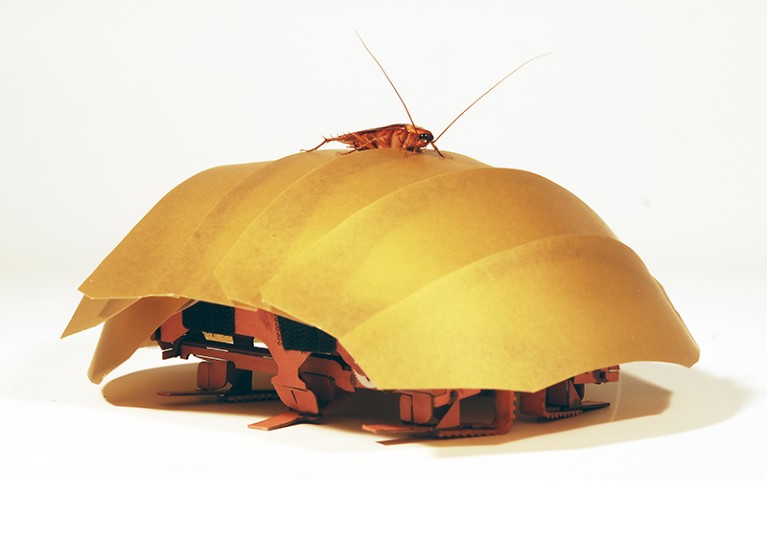
A compressible robot with articulated mechanisms, inspired by the simplicity of insects.Credit: Kaushik Jayaram, Animal Inspired Movement and Robotics Lab
The human brain contains an impressive 86 billion neurons, but insects get by with a lot fewer. The honeybee manages all its complex behaviours with about 1 million neurons, and the tiny Megaphragma mymaripenne wasp lives with fewer than 10,000. Studying how insects perform key tasks is giving scientists insight into how robots can achieve complex actions with limited processing power, pointing towards building them on the scale of flies and cockroaches.
A fleet of airborne, housefly-sized robots might prove useful for getting sensors to difficult-to-reach places, providing remote inspection inside, say, a pipeline or gathering data from a forest canopy. They should also be relatively safe to use around humans because of their weight. Most importantly, they present design challenges that engineers can learn from, says Sawyer Fuller, a mechanical engineer who runs the Autonomous Insect Robotics Lab at the University of Washington in Seattle. “There’s a lot to be learned from designing robots subject to extreme scale constraints,” he says. “We’ll learn how to make efficient avionics. We’ll figure out new ways to build mechanics. It’s going to force us to be ultra-miniature.”
Nature Index 2022 AI and robotics
In particular, because an insect-scale robot might carry only around 100 milliwatts of power, their design is prompting researchers to rethink how intelligence is incorporated. “Insects are believed to be simpler than vertebrates, so maybe they have simpler processing or intelligence mechanisms,” says Kaushik Jayaram, a roboticist who runs the Animal Inspired Movement and Robotics Laboratory at the University of Colorado Boulder.
One method might be to shift some control decisions away from the processors and into the physical design of a robot, essentially building the intelligence into the body. For instance, Fuller was working on a flying robot that needed to steer into the wind. The conventional approach would be for sensors to detect wind direction before a central processor steers the machine. Fuller found he could simply add fins to the rear of the robot and the way the air flowed around them would automatically turn the robot into the wind without any additional sensors.
Emulating insects’ sensory systems could also improve performance without adding power demands. In wind-tunnel tests, Fuller found flies controlled their navigation not just through vision, but also by sensing airspeed through the pressure of wind on their antennae. Combining different, low-resolution sensors may be more effective than trying to attach a sophisticated camera to a tiny body, he says.
Then there are the opportunities offered by tiny robots’ being able crash into an object without suffering major damage, because the force of the collision is small relative to their mechanical strength. Jayaram is trying to use this principle to emulate cockroaches. Instead of slowing down when they approach a wall, cockroaches run straight into it and use the force to tilt their bodies upwards to climb. Jayaram has demonstrated similar abilities in palm-sized robot cockroaches and he also hopes to build penny-sized robots that, by virtue of their geometry, can mimic cockroaches in the way they fold their bodies to squeeze through gaps as small as 3 millimetres.
Fuller is working on flying robots about the size of a bumblebee, weighing about the same as a toothpick, with wings made of polyester films supported by carbon fibres. He says that as well as nature inspiring specific functionality, engineers could also learn to evolve their mechanical designs and control systems in a similar way to the natural world, tweaking each version based on the successes and failures of previous iterations. Nature, Fuller says, “evolves both the body and the control system at the same time. In engineering, you learn how to design a control system, or you learn how to design a good robot arm. But this discipline of doing both of those at once is not so common.”
Jayaram, too, is sure that figuring out how insects handle challenges will point scientists to solutions. “As we start building more complex robotics that need to interface with the real world, nature can be a powerful teacher.”

 Harnessing AI and robotics for science and society
Harnessing AI and robotics for science and society
 Four ways that AI and robotics are helping to transform other research fields
Four ways that AI and robotics are helping to transform other research fields
 Growth in AI and robotics research accelerates
Growth in AI and robotics research accelerates
 Pandemic’s cancer backlogs receive treatment from AI innovation
Pandemic’s cancer backlogs receive treatment from AI innovation
 The rural areas missing out on AI opportunities
The rural areas missing out on AI opportunities
 Is big tech draining AI talent from academia?
Is big tech draining AI talent from academia?





